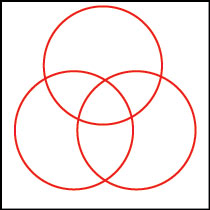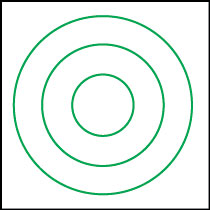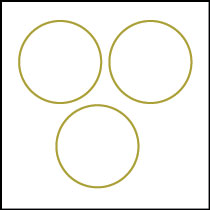Logical Reasoning Questions Practice Question and Answer
8 Q: Statements A>B>F>C
D>E>C
Conclusions. I. C<A
II. B>D
1787 15d4bfe3b0c5c9f706c695c02
5d4bfe3b0c5c9f706c695c02D>E>C
Conclusions. I. C<A
II. B>D
- 1If only conclusion I followstrue
- 2If only conclusion II followsfalse
- 3If either conclusion I or conclusion II followsfalse
- 4If neither conclusion I nor conclusion II followsfalse
- 5If both conclusion I and II followfalse
- Show AnswerHide Answer
- Workspace
- SingleChoice
Answer : 1. "If only conclusion I follows"
Q: Direction: In the following questions, the symbol @ , $, *, # and δ are used with the following meaning as illustrated below:
‘P $ Q’ means ‘P’ is not smaller than Q’.
‘P @ Q’ means ‘P is neither smaller than nor equal to Q’.
‘P # Q’ means ‘P is neither greater than nor equal to Q’.
‘P δ Q’ means ‘P is neither greater than nor smaller than Q’.
‘P * Q’ means ‘P is not greater than Q’.
Now in each of the following questions assuming the given statements to be true, find which of the four conclusion I, II , III and IV given below them is/are definitely true and given your answer accordingly.
Statements:
N δ B, B$W, W # H, H*M
Conclusion:
I. M @ W
II. H@N
III. WδN
IV. W#N
(A) only I is true
(B) Only III is true
(C) Only IV is true
(D) Only either III or IV is true.
(E) Only Either III or IV and I are 1704 05d89e3fb6b22180fc608f489
5d89e3fb6b22180fc608f489- 1Afalse
- 2Bfalse
- 3Cfalse
- 4Dfalse
- 5Etrue
- Show AnswerHide Answer
- Workspace
- SingleChoice
Answer : 5. "E"
Q: Statements
E=F˂G˂H
G ≥ I
Conclusions I. H˃I
II. E≥I
1623 05d4bfb622a48456849855b4a
5d4bfb622a48456849855b4aE=F˂G˂H
G ≥ I
Conclusions I. H˃I
II. E≥I
- 1If only conclusion I followstrue
- 2If only conclusion II followsfalse
- 3If either conclusion I or conclusion II followsfalse
- 4If neither conclusion I nor conclusion II followsfalse
- 5If both conclusion I and II followfalse
- Show AnswerHide Answer
- Workspace
- SingleChoice
Answer : 1. "If only conclusion I follows"
Q: In the question below, two statements are given followed by two conclusions numbered I and II. You have to take the two statements to be true even if they seem to be variance from the commonly known facts and then decide which of the given conclusions logically follows from the given statements disregarding the commonly known facts.
Statements: Some rings are circles.
No circle is a square.
Conclusion I. No ring is a square.
II. All rings are squares.
1612 05d4c0a4d0c5c9f706c69a99b
5d4c0a4d0c5c9f706c69a99bStatements: Some rings are circles.
No circle is a square.
Conclusion I. No ring is a square.
II. All rings are squares.
- 1If only conclusion I followstrue
- 2if only conclusion II followsfalse
- 3if either conclusion I or conclusion II followsfalse
- 4If neither conclusion I nor conclusion II followsfalse
- 5If both conclusions I and II followfalse
- Show AnswerHide Answer
- Workspace
- SingleChoice
Answer : 1. "If only conclusion I follows"
Q: Arrange the words given below in a meaningful sequence.
1. College
2. Child
3. Salary
4. School
5. Employment
1437 05ef41b7d7c1ec61320b5b713
5ef41b7d7c1ec61320b5b7131. College
2. Child
3. Salary
4. School
5. Employment
- 11,2,4,3,5false
- 22,4,1,5,3true
- 34,1,3,5,2false
- 45,3,2,1,4false
- Show AnswerHide Answer
- Workspace
- SingleChoice
Answer : 2. "2,4,1,5,3"
Q: In each of the following questions, five words are given. Which of them will come in the middle if all of them are arranged alphabetically as in a dictionary?
1357 05f6332eca372fb53670c7e8a
5f6332eca372fb53670c7e8a- 1Radiusfalse
- 2Radarfalse
- 3Radicalfalse
- 4Radiatetrue
- 5Racketfalse
- Show AnswerHide Answer
- Workspace
- SingleChoice
Answer : 4. "Radiate "
Q:Directions: In each of these questions, three words are related in some way. The relationship among the words in the question can best be represented by one of the five diagrams (a), (b), (c), (d) and (e) given below. Mark your answer accordingly.
Professor, Birds, Mice
1346 05ee1fee5ef054905196f712b
5ee1fee5ef054905196f712b- 1false

- 2false

- 3false

- 4false

- 5true

- Show AnswerHide Answer
- Workspace
- SingleChoice
Answer : 5. "
"

Q: In the following question two statements are given. Identify which of the statements is/are necessary /sufficient to answer the question.
Question:
Among the bags A, B, C and D which one is the lightest bag?
Statements:
1. B is heavier than A.
2. A is lighter than C and D.
1328 05f96a099d8201a50c262d064
5f96a099d8201a50c262d064Question:
Among the bags A, B, C and D which one is the lightest bag?
Statements:
1. B is heavier than A.
2. A is lighter than C and D.
- 1Statement 2 alone is sufficientfalse
- 2Statement 1 and 2 together are necessarytrue
- 3Statement 1 alone is sufficientfalse
- 4Statement 1 and 2 are not sufficient to solvefalse
- Show AnswerHide Answer
- Workspace
- SingleChoice

